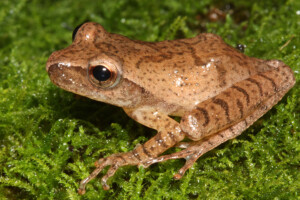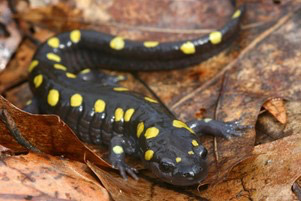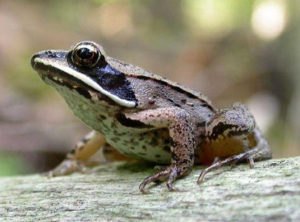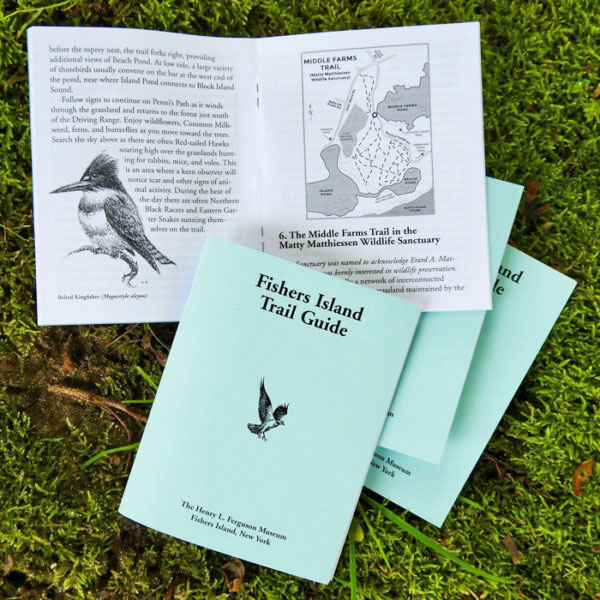Pool Party for Spring Peepers
Museum April 2020

Spring Peeper
The wonders of nature never cease, and in our current circumstances time spent focusing on the natural world provides a welcome relief from the news. Spring has arrived and with it comes the nighttime sound that heralds the change in seasons: the high-pitched song of adult wood frogs and spring peepers. Along with other amphibians, they will be finding their way to vernal pools in this annual rite of spring. The vernal cacophony of spring peepers and wood frogs is the evening symphony that ushers us all into summer!
What Is a Vernal Pool?

Spotted Salamander
Vernal pools are low-lying depressions typically found in woodlands. They fill with spring meltwaters and rainfall runoff and typically lack an inlet and/or outlet. While they cannot support fish, these wetland areas provide refuge for obligate vernal pool species. Some of the commonly found species using vernal pools include the spotted salamander and wood frog. Less common species found using vernal pools include the Jefferson salamander, blue-spotted salamander and fairy shrimp (these particular species have not been confirmed on Fishers Island). Vernal pool activity is a spring phenomenon that exhibits the complexity of nature.
Vernal Pools on Fishers Island
The surface geology of Fishers Island supports a number of ephemeral depressions that provide breeding habitats for obligate amphibians, meaning species that depend on vernal pools. The first warm rainy night of the spring is known as “Big Night” in the herpetological world and marks the eve of the salamander and frog migration to the pools. Keep a careful eye as you drive on the roadways that cross between uplands and wetland depressions to avoid crushing a hopeful amphibian on the way to its breeding ground. (One such area is on the East End road near the Boker Doyle Trail and Grey Gulls.)
Why Are Vernal Pools Important?
 Obligate vernal pool species depend on vernal pools to complete their breeding cycle. Vernal pools are the only viable breeding ground available to these species and are therefore critical for sustaining amphibian populations. Wood frogs and salamanders deposit fist-sized egg masses, often attached to vegetation and/or woody debris. Wood frogs tend to cluster their egg masses within one communal area within the pool, whereas spotted salamander egg masses are typically distributed sporadically within a vernal pool.
Obligate vernal pool species depend on vernal pools to complete their breeding cycle. Vernal pools are the only viable breeding ground available to these species and are therefore critical for sustaining amphibian populations. Wood frogs and salamanders deposit fist-sized egg masses, often attached to vegetation and/or woody debris. Wood frogs tend to cluster their egg masses within one communal area within the pool, whereas spotted salamander egg masses are typically distributed sporadically within a vernal pool.
Egg masses generally incubate for three to four weeks to hatch tadpoles. Newly metamorphosed frogs begin migrating out of the pools three to four weeks later, generally in early June (though it can be as late as early July), often finding refuge in the bordering wetlands and uplands. Vernal pools typically dry up during the summer (late July through September), thereby keeping potential predators such as fish from inhabiting pools.
Vernal pools are vital to maintaining healthy amphibian populations and ecosystem biodiversity.
Listen to the sound of spring peepers
Find a different path to experience the great outdoors.
The Museum Land Trust trails are open for walking and are there to be enjoyed. The Museum’s Land Trust asks that when encountering other walkers on the trails that you respectfully space yourselves at a 6- to 10-foot distance off the side of the trail and allow others to pass.
If you would prefer a paper copy, please call or email the Museum to arrange for a contact-free pick up. 401-788-7239 or fimuseum@fishersisland.net
Please follow these guidelines for the safe use of the trails.
- Do not visit the Land Trust trails if you feel ill or are exhibiting symptoms of illness.
- Maintain a minimum distance of 6 feet between persons.
- Do not gather in groups of more than 10 people.
- Follow CDC’s guidance on personal hygiene prior to and during use of trails.
- Wash your hands, carry hand sanitizer, cover your mouth and nose when coughing or sneezing.


